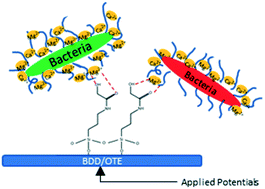Bacteria poration on modified boron-doped diamond electrode surfaces induced by divalent cation chelation†
Abstract
This research investigated mechanisms for biofouling control at modified boron-doped diamond (BDD) electrode surfaces polarized at low applied potentials (e.g., −0.2 to 1 V versus Ag/AgCl), using Pseudomonas aeruginosa (PAO1) as a model pathogenic organism. Results indicated that electrostatic interactions and electrochemical reactions under polarized conditions can affect cell attachment and poration, respectively. However, results suggested that divalent ions from the outer membrane of PAO1 can be chelated by N-propyl-2-hydroxyacetamide functional groups that were immobilized on a BDD optically transparent electrode (termed OH-BDD/OTE). It was observed that two- to three-fold higher percentage of porated bacteria were observed on the OH-BDD/OTE compared with BDD/OTE under applied anodic potentials between 0.1 to 0.5 V vs. Ag/AgCl. Density functional theory calculations indicated that the chelation mechanism was thermodynamically favorable. Zeta potential measurements of the PAO1 bacteria as a function of chelator and Mg2+ concentrations were performed and interpreted using a mathematical model based on the nonlinear Poisson–Boltzmann equation. Results supported the chelation mechanism for bacteria poration, which indicates that electrode modification may be a viable method to prevent biofouling of electrode surfaces that are operated at low applied potentials.



 Please wait while we load your content...
Please wait while we load your content...
